Planetary Microlensing OGLE 2003-BLG-235/MOA 2003-BLG-53
FIRST DETECTION of an EXTRASOLAR PLANET with MICROLENSING
OGLE 2003-BLG-235/MOA 2003-BLG-53 was detected by the
OGLE
EWS [opens in new window]
System on June 22, 2003 and by the
MOA
group on July 21, 2003. The event resembled the
typical single lens light curve [opens in new window]
for most of its duration. But for a period of about a week (July 17-21,
2003; HJD 2452835-2452842), the gravitational field of the planet caused
the light curve to resemble that of a
double star lens [opens in new window].
The precise shape of the light curve reveals that the lighter mass of
the double lens has only 0.4% of the mass of the heavier component,
which implies that the lighter component must be a planet.
Light curve of OGLE 2003-BLG-235/MOA 2003-BLG-53 in different
time scales:
Main phases of the OGLE 2003-BLG-235/MOA 2003-BLG-53 microlensing event and
the light curve in 2001 - early 2004:

Close-up around the planetary deviation and crossing of the second caustic:

Equatorial coordinates of OGLE 2003-BLG-235/MOA 2003-BLG-53:
RA = 18:05:16.35 DEC = -28:53:42.0 (J2000.0)
OGLE images of OGLE 2003-BLG-235/MOA 2003-BLG-53: 20''×20''
I-band image centered on the source star when it was
unmagnified (left) and magnified by a factor of about 7 (right). North
is at the top and East to the left.
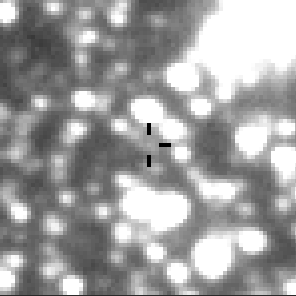
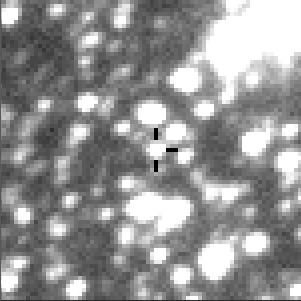
OGLE photometric data of OGLE 2003-BLG-235/MOA 2003-BLG-53
(regularly updated when additional observations of the lens field are
collected) are available from the
OGLE 2003-BLG-235 EVENT PAGE [opens in new window].
MOA photometric data of OGLE 2003-BLG-235/MOA
2003-BLG-53 are available HERE.
Parameters of the OGLE 2003-BLG-235/MOA 2003-BLG-53 event
from the best microlensing model (green line in Figures):
| Mplanet/Mstar | (Mass ratio of the lens components) | 0.0039 +0.0011-0.0007 | ||||
| aproj/RE | (Projected
separation of the lens components in Einstein ring units) | 1.120 ±0.007 | ||||
| φ | (Position angle) | 223.8 ±1.4 [deg] | ||||
| u0 | (Impact parameter in
Einstein ring units) | 0.133 ±0.003 | ||||
| t0 | (Time of the closest approach
to the center of mass) | 2848.06 ±0.13 [HJD-2450000] | ||||
| tE | (Einstein ring crossing time) | 61.5 ±1.8 [days] | ||||
| θsrc/&thetaE |
(Ratio of angular radius of the source star to that of the Einstein ring) | 0.00096 ±0.00011 | ||||
| I0 | (Unmagnified brightness of the
source star in the I-band) | 19.70 ±0.15 [mag] | ||||
| Ibaseline | (I-band
magnitude of the blend at baseline) | 19.39 ±0.03 [mag] |
Estimation of parameters of the lensing system:
| Mstar | (Mass of the star) | 0.36 +0.03-0.28 [MSun] | ||||
| Mplanet | (Mass of the planet) | 1.5 +0.1-1.2 [MJupiter] | ||||
| a | (Projected distance) | 3.0 +0.1-1.7 [AU] | ||||
| Dlens | (Distance to the lensing system) | 5.2 +0.2-2.9 [kpc] |
Magnification map of the lensing system in OGLE 2003-BLG-235/MOA 2003-BLG-53.
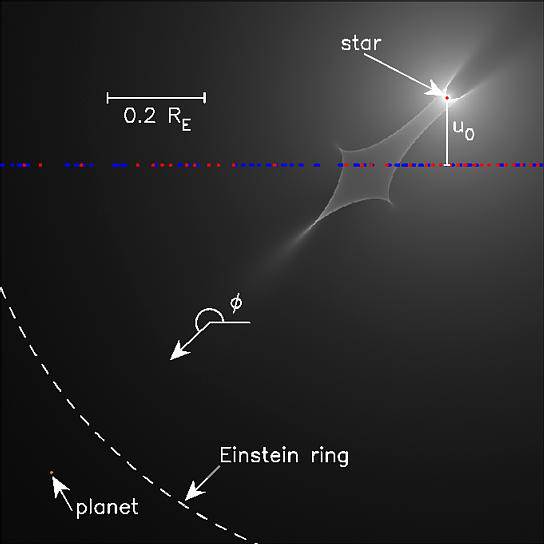
Magnification map of the lensing system in OGLE 2003-BLG-235/MOA
2003-BLG-53 (projected on the sky). The dark to bright regions show
progressively higher magnifications. The source star moves from left to
right along the trajectory shown as the series of dots. Each dot represents
a single measurement from either OGLE (red) or MOA (blue). The
magnification is locally greatest when the source star crosses the boundary
of the caustic region. The definitions of the parameters u0 and
φ are shown along with the positions, on the map, of the star and
planet components of the lens.
More details on the discovery can be found in the paper:
OGLE 2003-BLG-235/MOA 2003-BLG-53: A Planetary Microlensing Event.
I. A. Bond, A. Udalski, M. Jaroszynski, N. J. Rattenbury, B. Paczynski,
I. Soszynski, L. Wyrzykowski,
M. K. Szymanski, M. Kubiak, O. Szewczyk,
K. Zebrun, G. Pietrzynski, F. Abe, D. P. Bennett, S. Eguchi, Y. Furuta,
J. B. Hearnshaw, K. Kamiya, P. M. Kilmartin, Y. Kurata, K. Masuda, Y.
Matsubara, Y. Muraki, S. Noda, K. Okajima, T. Sako, T. Sekiguchi, D. J.
Sullivan, T. Sumi, P. J. Tristram, T. Yanagisawa, and P. C. M. Yock, 2004,
ApJ,
606, L155
(astro-ph/0404309)
The paper is also available here
in gzipped Postscript or
PDF format.
Press release on the discovery.
NASA
press release on the discovery and WWW page
Animation of the OGLE 2003-BLG-235/MOA 2003-BLG-53 microlensing event: (red
circle in the sky image indicates planetary deviation; green circle -
regular stellar microlensing)
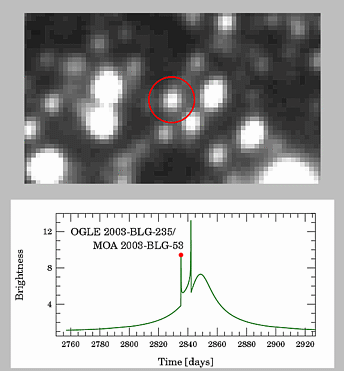
[Click the image above to see animation (GIF format - 4 MB).]
This animation is also available in
MPEG format (0.5 MB) and
AVI format (160 kB).
How the OGLE 2003-BLG-235/MOA 2003-BLG-53 microlensing event happened:
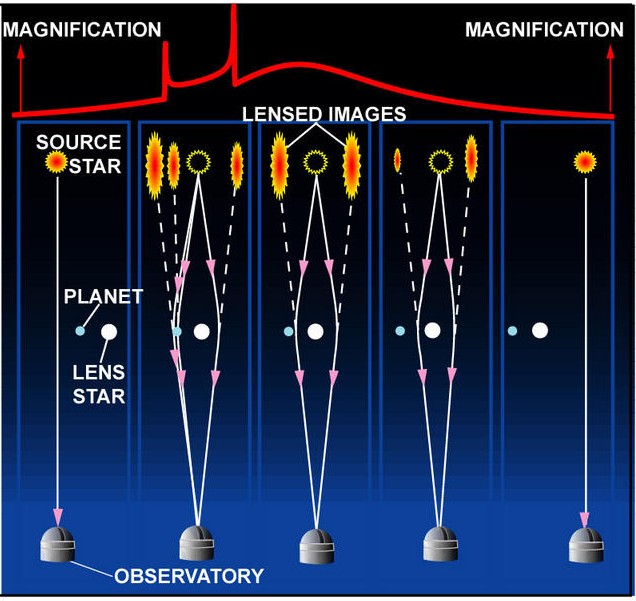
This Figure shows the geometry of a microlensing event in which the almost
perfect alignment between a background source star, a lens star, and our
observatory allow us to discover a planet that orbits the lens star. Each
panel represents a different time in the history of the event, and time can
be taken to run from either left to right or right to left depending on the
motion of the lens and source stars. The left and right panels show the
usual case in which the alignment is not good enough for the lens star or
its planet to affect the light rays that we see. The third and fourth
panels (from the left) show the case of lensing by a star: the light rays
from the background source star are bent so that two distorted images of
star are visible. These images cannot be resolved without a telescope with
much sharper images than Hubble Space Telescope, but the overall
magnification of the images is visible as an apparent brightening of the
source star. The second panel shows the configuration for a planet
detection. One of the light rays that is bent by the lens star's gravity
comes close enough to the planet that it feels the gravity of the planet,
too. This causes additional distortion of the images, and in some cases,
additional images can be created which result in dramatic changes in
brightness (the spikes seen in the magnification curve).
Animations of the OGLE 2003-BLG-235/MOA 2003-BLG-53 microlensing event by
B. Scott Gaudi (Harvard-Smithsonian Center for Astrophysics
showing models of planetary microlensing):
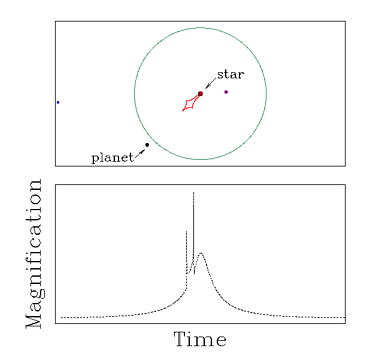
[Click the image above to see animation.]
This animation shows the OGLE 2003-BLG-235/MOA 2003-BLG-53 microlensing
event in ultra-high angular scale. In the upper panel the position of the
lensing star and its planet projected on the sky are marked. The circle
presents the Einstein ring which in the case of OGLE 2003-BLG-235/MOA
2003-BLG-53 has the radius of about half milli-arcsecond. Blue dot
indicates position of the source star (located in the Galactic center) as
it moves during the event. Violet spots show the images of the source star
caused by microlensing. Brightness of images is proportional to their
area. When the source star moves toward the lensing system two standard
images are created by microlensing caused by the lensing star. They move
along well known trajectories - one outside and the other inside the
Einstein ring. If a planet is located close to any of these images it
disturbs them due to additional "planetary" microlensing of one of the
standard images.
In the case of OGLE 2003-BLG-235/MOA 2003-BLG-53 additional "planetary"
images are created leading to the deviation from the typical single star
microlensing event. The red contour indicates the area which when crossed
by the source star (blue dot) produces most prominent planetary deviation
in this star-planet configuration. The lower panel shows magnification of
the source star during the event, i.e., the total brightness of all
microlensing images (as they cannot be resolved by modern astronomical
instruments). The change of brightness due to presence of a planet is the
highest when the source star crosses the caustic (red contour) and
additional "planetary" microlensing images turn on or off.
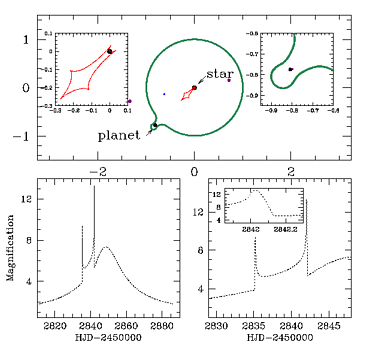
[Click the image above to see animation.]
This animation presents more technical details on the OGLE 2003-BLG-235/MOA
2003-BLG-53 microlensing event. The upper panel shows the close-up of the
caustic region (left inset) and the planet area (right inset). The X and Y
axes are in Einstein ring radius units. The lower panels present the light
curve in different time scales.
 back
back